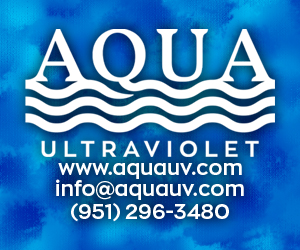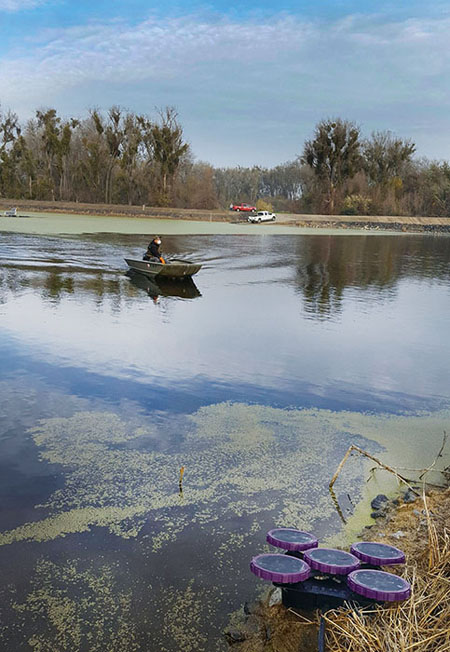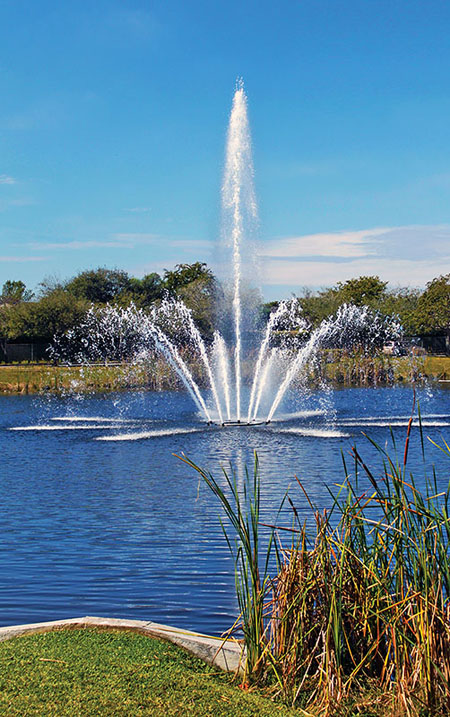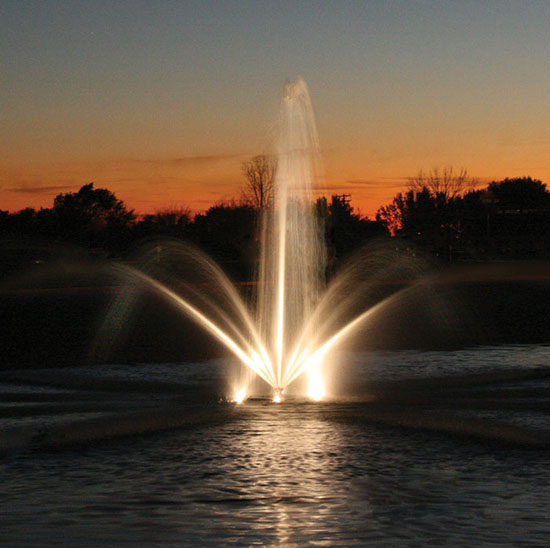Aeration introduces oxygen into an aquatic ecosystem through various methods. Air compressors, waterfalls and fountains inject small oxygen bubbles, increasing the dissolved oxygen (DO) level of the water feature. DO is one of the most important facets of a healthy body of water, since it affects overall water quality, fish and plant health, not to mention many other more subtle processes. Low DO in ponds often results in sick or dying flora and fauna, accelerated muck accumulation and foul odors.
The inevitable result of low DO is the reduced efficiency of bacterial use of organic matter. Accumulated organic matter thickens at the pond’s bottom, reducing overall depth. Additional decaying matter exacerbates health challenges, causing the biosphere to slowly destabilize, favoring the abundance of toxic algae and cyanobacteria. When the DO level drops, bacterial species use more nitrates to function. But as nitrates are vital to plant survival as well, if bacteria are utilizing the same resource, the plants start to suffer. When nitrates become scarce, bacteria will start processing sulfates. The waste product of bacteria consuming sulfates is hydrogen sulfide (H2S), which is toxic to fish and other aquatic organisms and gives water the smell of rotten eggs.
Harmful Algal Blooms
A vulnerable pond that suffers from a combination of low DO and bio-imbalance only needs a slight push to generate a harmful algal bloom (HAB), which can be dangerous to humans and deadly to smaller animals. HABs tend to accompany shifts in water health. Higher temperatures in recent decades have created an environment well suited to HABs, some of which are not algae at all, but cyanobacteria. Cyanobacteria, the oldest of all life on Earth, are always present and waiting for an opportunity to expand. A large influx of decaying matter allows algae and bacteria populations to expand their colony size. This colony increase will continue past the stasis point, which ultimately depletes the available nutrients. Once the carrying capacity of the water is exceeded, the algae starts a die-back process, leaving their biomass behind. The pond is then incapable of handling all this decaying organic matter, so buildup continues unabated.
In a healthy ecosystem, bacteria slow the accumulation of solids, help reduce odors and assist in the maintenance of a pond’s depth. Maintaining healthy DO is vital to a pond’s life and relies on a balance of organisms, many of which rely on a delicate combination of factors such as DO, temperature, nutrients, pH, time of year and chemistry. Maintaining a healthy pond is a subtle art form.
The Aeration Effect
The most effective long-term solution to treat an unhealthy pond is to install an aeration system. Aeration systems, composed of a combination of air compressors, waterfalls and fountains, inject DO while promoting circulation. Each of these mechanisms delivers its own set of advantages, as they mimic nature. Aquatic experts know what depths, circulation, temperatures and water chemistry work best, which in turn favor fish and plant species.
Stratification, a natural phenomenon that works against pond diversity, occurs when water splits into layers based on depth and temperature. Anyone who has dived down into a body of water has experienced stratification firsthand. As one descends, at a certain depth, the water suddenly gets much colder. Stratification restricts DO and nutrients to particular areas.
Aeration is the process of purposely and mechanically causing the different layers to mix. Combining aeration with a proper application of treatments, both biological and chemical, a pond can remain healthy even under dramatic shifts in the environment. Turnover, or the natural mixing of layers, occurs with seasonal changes. This natural mixing of stratified layers due to convection, usually in spring and fall, can cause a dramatic downturn in an already unhealthy body of water.
Mechanical aerators use pumps to pull water from the bottom of the water column, inject pressurized air using a compressor, and then push this enriched mixture to the surface. Aerators work best below a certain depth. Exchanging the bottom water layer with the surface mixes DO levels, water temperature and water chemistry into a more homogeneous distribution at all levels. This sharing of water chemistry increases overall organism populations and diversity. This invigorates pond organisms, allowing them to survive a wider range of environmental pressures, such as seasonal changes and increased pollution. Aeration is not a solution for all water problems, but increasing DO is a great tool for boosting an ecosystem’s health and invigorating fish and plants.
For a pond that is currently still and stratified, the deepest layer may be devoid of oxygen. This is known as anoxic water. If this layer is mixed suddenly with normally high DO water at the surface, the sudden shift can be deadly for aquatic life. Drastic turnovers tend to cause a kill-off in the pond’s biosphere, which is another harbinger for HABs. While oxygen can be sparse in deep water, most of the nutrients are also in this layer. When these nutrients get circulated into the upper layer of the pond, opportunistic organisms begin to multiply. If their natural competitors have simultaneously died off, this multiplication can happen at an astounding rate. As algae decompose the solids in the water column, they consume oxygen, which reduces DO levels and causes fish to suffocate. Dead fish are often the first visual sign that the hidden weakness of a pond has triggered an especially bad cycle.
Tools of the Trade
Once the basics of aeration, turnover and biodiversity are grasped, a pond manager would do well to gather all the necessary tools. The most effective are knowledge and patience, but valuable tangible tools include a muck reducer, a clarifier or flocculent, an aquatic pond dye, a low-copper algaecide and an enzyme-mineral-bacterial supplement. Also make sure to have some hardy jeans, goggles and water-resistant gloves.
If fish are to be stocked, one should probably delay their introduction until the pond has reached its new balance. As always, consult a fish expert regarding new stock introduction, especially when upgrading your pond. You also may want to talk to an aquatic expert if landscaping is planned near a water feature, so that you can avoid structural investments that could cause chronic issues like nutrient introduction.
Beginning with the muck reducer is often wisest, depending on the total pond depth. The ratio of muck to water and the muck’s composition are both important factors. As is true with most applications, treat about 1/3 of the total area of water at any one time. This allows your fish and other organisms to move away from danger zones while a new stasis is reached. As you shift from one section of the pond to another on successive days, you will be tempted to go all-in as more progress is observed. But, patience is key. As the pond metabolizes each step toward a new balance, the various species can adjust. By reducing the muck first, the pond will have fewer nutrients available to complicate the next step.
Treating the pond with an aquatic-labeled dye is now advisable. Follow the instructions carefully, and remember — you can always add more, but you cannot add less! Owners and guests are accustomed to the historic color of the water feature, so this step may be unsettling. The point here is not to create an artificial color, but rather to reduce photosynthetic feeding for the native algae. Allow the pond residents to adjust over a day or two before turning on the pumps. When the pumps are engaged, driving the aerators, waterfall or fountain, the remaining muck will begin to break up and surface. If the temperature is unusually warm and the sun is brilliant, the algae population will increase in the top water layer.
This aquatic dye will impede algal expansion at lower depths where the sunlight is reduced, but not at the surface. This is why an algaecide is applied at this stage. For best results, use a double-chelated copper solution in liquid form, such as F-30 Algae Control. Most other products will interact with the water minerals quickly and precipitate into the bottom soil, requiring added product for the same outcome. Again, treat 1/3 of the surface area at a time; follow the product label instructions carefully; and consult an aquatic expert as needed. When applied correctly, the algae or HABs will slow their life cycle at about 0.2 ppm copper. At 0.6 ppm, the process is probably at maximum efficiency. For lower-quality algaecides, application may need a full 1.0 ppm, which is the limit for potable water copper toxicity.
Turbidity
If a pond has catfish, they will not appreciate the reduction in muck, but they will love the increased turbidity. Bottom feeders use the muck cover for concealment and avoiding predators. Koi are fine in a certain amount of turbidity, but most pond owners with koi would rather see and admire their fish. The other problems with too much turbidity are filtration issues and blocking the life cycle of non-algal species. To manage turbidity is more than an aesthetic issue; this stage of treatment fine-tunes the biosphere to encourage diversity.
Less is more. Quality clarifiers and flocculants are highly concentrated, so do not dilute them prior to application. Clean spills and spotting with a dry absorbent or cloth. Many aquatic experts have learned the hard way how messy things can become when this vital tool is mishandled. As the pond is seeking a new, healthy balance, the flocculants bind the materials causing turbidity, returning them back to the bottom, where a now healthier mix of organisms maintain the beneficial layer of muck.
The Big Picture
Humans tend to assume that a pond automatically has all the nutrients, biological species and minerals it needs. In many ways, a pond is just like a human body. Both need “good stress” combined with supplements and rest periods.The last stage of a pond’s rehabilitation or upgrade is the addition of supplements to allow for a healthy new biosphere. The main concern is to choose the product carefully, as there are nearly as many crazy people selling pond supplements as there are selling human supplements. Technology is useful in weeding out the crazies. Find a long-serving aquatic expert with a good reputation. There are easy-to-use pond kits available that can make this step simple — or, at least, less mysterious.
Admiring a beloved water feature is a privilege, as water is the core of life. Just as all people love water, there is also a universal knowledge gap in pond processes, bio-balance, life cycles, environmental threats and treatments. A still pond will accumulate a thicker covering of plants, which further conceals and increases the suffocating loss of DO, triggering a slow-motion shift from diversity to an algal explosion. HABs are nature’s ultimate bio-assassin, which kills a pond and then slowly turns it into swampland. We have the tools to repair our domestic water features before they crash and die.
Human nature is defined by making our environment more livable, and then more enjoyable. Your pond benefits from slow and deep breaths of oxygen, gradually stretching her stratified layers and cleaning out the accumulated muck. The reward is stronger, ever-renewing biodiversity, which supports the larger animal and plant species, including us humans.






